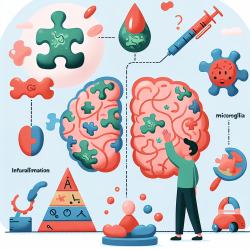Introduction
As a speech-language pathologist dedicated to data-driven decisions, it's crucial to stay abreast of the latest research to enhance our practice. A recent study, "Relevance of Neuroinflammation and Encephalitis in Autism," offers groundbreaking insights that could transform how we approach autism spectrum disorder (ASD). This blog explores the study's findings and their implications for practitioners.
Understanding Neuroinflammation in Autism
Recent research indicates that a significant number of children with ASD exhibit brain pathology suggestive of ongoing neuroinflammation or encephalitis. This includes microglial and astrocytic activation, elevated proinflammatory cytokines, and aberrant expression of nuclear factor kappa-light-chain-enhancer of activated B cells (NF-κB). A conservative estimate suggests that at least 69% of individuals with ASD experience microglial activation or neuroinflammation.
Why This Matters
Currently, children with ASD are not routinely assessed for encephalitis, a medical condition defined as brain inflammation. This oversight is significant because addressing underlying brain inflammation could lead to improved outcomes. Recognizing encephalitis as a potential component of ASD could drive more immediate and targeted treatments, potentially reducing or eliminating ASD symptoms in some children.
Implications for Practitioners
For practitioners, this research underscores the importance of considering neuroinflammation in the diagnostic and treatment process for ASD. Here are actionable steps you can take:
- Advocate for Comprehensive Assessments: Encourage assessments that include biomarkers of neuroinflammation, such as cytokine profiles and microglial activation.
- Collaborate with Medical Professionals: Work closely with neurologists and immunologists to explore potential medical interventions for children showing signs of neuroinflammation.
- Stay Informed: Keep up-to-date with the latest research on neuroinflammation and its role in ASD to inform your practice.
Encouraging Further Research
While the current study provides valuable insights, it also highlights the need for further research. Larger studies examining multiple brain regions and additional markers of neuroinflammation could provide a more accurate estimate of the prevalence of neuroinflammation in ASD. As practitioners, supporting and advocating for such research is crucial.
Conclusion
The findings from the study "Relevance of Neuroinflammation and Encephalitis in Autism" present a compelling case for re-evaluating how we diagnose and treat ASD. By recognizing the potential role of neuroinflammation, we can work towards more effective, targeted interventions that improve outcomes for children with ASD.
To read the original research paper, please follow this link: Relevance of Neuroinflammation and Encephalitis in Autism.










